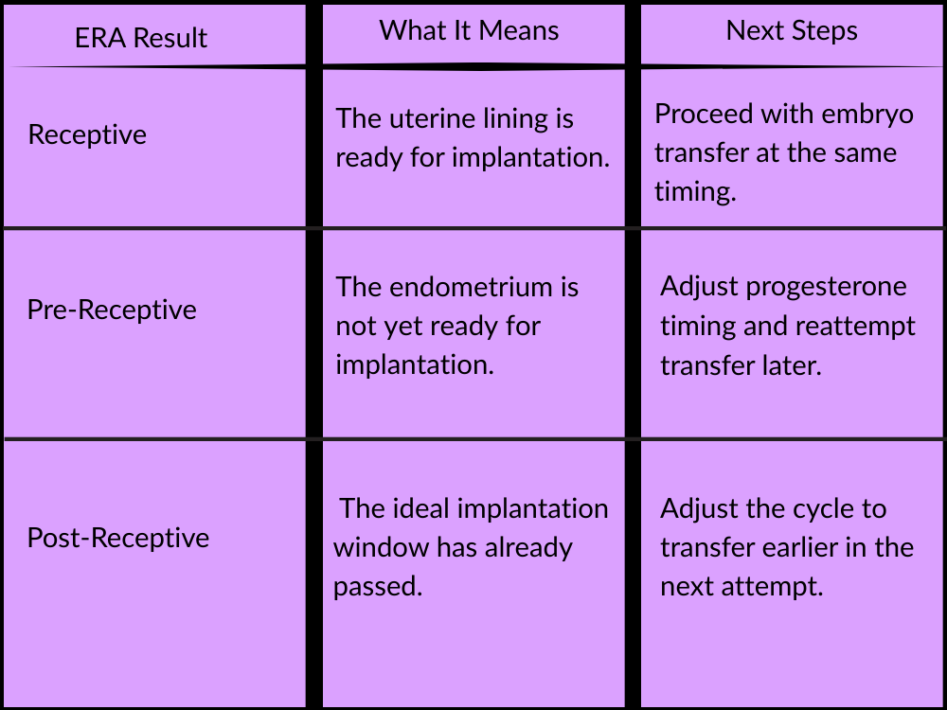Endometrial Receptivity Assay (ERA)
- EVA IVF & Women’s Centre
- Services
- Endometrial Receptivity Assay (ERA)
At Eva IVF & Women’s Centre, we understand that successful embryo implantation depends on the precise timing of uterine receptivity. Endometrial Receptivity Assay (ERA) is an advanced diagnostic test that helps determine the best time to transfer an embryo during IVF, maximizing implantation success.
This guide is specifically for couples considering ERA as part of their fertility treatment. We’ll walk you through the procedure, who needs it, success rates, and benefits to help you make an informed decision.
What is Endometrial Receptivity Assay (ERA), and Who Needs It?
Endometrial Receptivity Assay (ERA) is a genetic test that evaluates the optimal implantation window in the uterus. By analyzing over 200 genes, ERA determines whether the endometrium (uterine lining) is receptive, pre-receptive, or post-receptive for embryo implantation.
Who Should Consider ERA?
✔ Women with Recurrent IVF Failures Despite Good Embryo Quality
✔ Women with Unexplained Implantation Failure
✔ Women with Irregular Menstrual Cycles Affecting Uterine Receptivity
✔ Couples Using Frozen Embryo Transfer (FET) for a More Precise Implantation Window
✔ Women with Suspected Endometrial Issues Affecting Pregnancy Success

💡 ERA helps identify the exact implantation window, improving IVF success rates in women with recurrent implantation failure.
How Does ERA Work? (Step-by-Step Process)
1. Preparing the Uterine Lining
✔ The woman undergoes an endometrial preparation cycle with hormonal medications (estrogen and progesterone) to mimic a natural implantation phase.
2. Endometrial Biopsy Collection
✔ A small tissue sample is taken from the uterine lining using a thin catheter.
✔ This minimally invasive procedure is performed in the clinic and takes only a few minutes.
3. Genetic Testing of Endometrial Tissue
✔ The biopsy is sent to a specialized laboratory, where over 200 genes related to implantation receptivity are analyzed.
4. Results & Personalized Transfer Timing
✔ The ERA test determines if the endometrium is Receptive, Pre-Receptive, or Post-Receptive at the time of biopsy.
✔ If Pre-Receptive or Post-Receptive, the embryo transfer timing is adjusted for future cycles.
✔ The next IVF or Frozen Embryo Transfer (FET) cycle is scheduled accordingly to align with the optimal implantation window.

💡 ERA eliminates guesswork, ensuring embryos are transferred at the most fertile moment.
ERA Test Results & What They Mean

💡 Women with recurrent implantation failure often have a shifted implantation window that requires personalized embryo transfer timing.
ERA vs. Standard Embryo Transfer Timing

💡 ERA offers a personalized approach, increasing the success of embryo implantation compared to standard transfer protocols.
Success Rates of Endometrial Receptivity Assay (ERA)
How Does ERA Improve IVF & Frozen Embryo Transfer (FET) Outcomes?
✔ ERA-Guided Embryo Transfer Improves Pregnancy Rates by 20-50%.
✔ Higher Live Birth Rates in Women with Recurrent Implantation Failure.
✔ Reduces the Number of Failed IVF Cycles by Aligning Transfer with the Optimal Window.
✔ Improves Implantation Success, Minimizing the Need for Multiple Transfers.
💡 ERA increases the precision of embryo transfer timing, leading to higher pregnancy success rates.

Benefits of ERA – Why Choose This Test?
🌟 Identifies the Exact Implantation Window for Higher IVF Success
🌟 Reduces Implantation Failures & Recurrent Pregnancy Loss
🌟 Improves Live Birth Rates by Personalizing Transfer Timing
🌟 Eliminates Guesswork in Uterine Receptivity, Maximizing Pregnancy Potential
🌟 Especially Beneficial for Women with Recurrent IVF Failures
💡 ERA is a game-changer in reproductive medicine, offering precision-based embryo transfer timing for better IVF outcomes.
Who is NOT Suitable for ERA?
❌ Women with Structural Uterine Abnormalities That Affect Implantation
❌ Women Who Have Achieved Pregnancy Easily in Previous IVF Cycles
❌ Couples Without a History of Implantation Failure or Recurrent IVF Failures
💡 A fertility specialist will evaluate your history before recommending ERA.

How to Ensure Accurate ERA Results?
✔ Follow the Prescribed Hormonal Protocol to Mimic a Real Transfer Cycle
✔ Avoid Uterine-Stimulating Activities (Intense Exercise, Intercourse) Before the Biopsy
✔ Stay Hydrated & Maintain a Healthy Diet for Optimal Endometrial Health
✔ Manage Stress & Get Proper Sleep for a Balanced Hormonal Response
💡 Proper preparation ensures reliable ERA test results and a personalized embryo transfer plan.
What Happens After ERA?

✔ Discuss Results with Your Fertility Specialist & Adjust Transfer Timing
✔ Proceed with Personalized Frozen Embryo Transfer Based on Your Receptivity Window
✔ Continue Hormonal Medications as Prescribed for Endometrial Preparation
✔ Follow a Healthy Lifestyle to Support Implantation Success
💡 Once the receptivity window is identified, future embryo transfers can be planned with higher accuracy.
